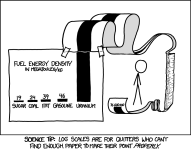lpetrich
Contributor
Australia now has more than 9GW of small scale rooftop solar | RenewEconomy
[TABLE="class: grid"]
[TR]
[TD]State[/TD]
[TD]Sys[/TD]
[TD]Size[/TD]
[TD]Cap[/TD]
[TD]Pop[/TD]
[TD]SPP[/TD]
[/TR]
[TR]
[TD]ACT[/TD]
[TD]24[/TD]
[TD]4.30[/TD]
[TD]103[/TD]
[TD]397397[/TD]
[TD]0.060[/TD]
[/TR]
[TR]
[TD]NSW[/TD]
[TD]489[/TD]
[TD]4.26[/TD]
[TD]2083[/TD]
[TD]7955900[/TD]
[TD]0.061[/TD]
[/TR]
[TR]
[TD]NT[/TD]
[TD]13[/TD]
[TD]6.82[/TD]
[TD]86[/TD]
[TD]246700[/TD]
[TD]0.053[/TD]
[/TR]
[TR]
[TD]QLD[/TD]
[TD]630[/TD]
[TD]4.14[/TD]
[TD]2609[/TD]
[TD]4827000[/TD]
[TD]0.131[/TD]
[/TR]
[TR]
[TD]SA[/TD]
[TD]254[/TD]
[TD]4.28[/TD]
[TD]1086[/TD]
[TD]1706500[/TD]
[TD]0.149[/TD]
[/TR]
[TR]
[TD]TAS[/TD]
[TD]35[/TD]
[TD]4.12[/TD]
[TD]143[/TD]
[TD]518500[/TD]
[TD]0.068[/TD]
[/TR]
[TR]
[TD]VIC[/TD]
[TD]411[/TD]
[TD]4.32[/TD]
[TD]1776[/TD]
[TD]6430000[/TD]
[TD]0.064[/TD]
[/TR]
[TR]
[TD]WA[/TD]
[TD]300[/TD]
[TD]3.87[/TD]
[TD]1160[/TD]
[TD]2613700[/TD]
[TD]0.115[/TD]
[/TR]
[TR]
[TD]Total[/TD]
[TD]2156[/TD]
[TD]4.20[/TD]
[TD]9046[/TD]
[TD]24695697[/TD]
[TD]0.087[/TD]
[/TR]
[/TABLE]
Here are the numbers:Australia has broken through another key milestone in small-scale rooftop solar capacity, with 9GW now installed across the country and the 10GW mark likely to be broken by the end of the calendar year.
According to the latest data from Sunwiz, Australia added 156MW of small scale rooftop solar capacity (systems of less than 100kW) in the month of June, taking the year to date total to nearly 1GW, and the grand total to 9.04GW.
“We are about to cross the 1GW threshold for the sub-100kW market, so we’re on track for a 2GW year,” says Sunwiz director Warwick Johnston.
[TABLE="class: grid"]
[TR]
[TD]State[/TD]
[TD]Sys[/TD]
[TD]Size[/TD]
[TD]Cap[/TD]
[TD]Pop[/TD]
[TD]SPP[/TD]
[/TR]
[TR]
[TD]ACT[/TD]
[TD]24[/TD]
[TD]4.30[/TD]
[TD]103[/TD]
[TD]397397[/TD]
[TD]0.060[/TD]
[/TR]
[TR]
[TD]NSW[/TD]
[TD]489[/TD]
[TD]4.26[/TD]
[TD]2083[/TD]
[TD]7955900[/TD]
[TD]0.061[/TD]
[/TR]
[TR]
[TD]NT[/TD]
[TD]13[/TD]
[TD]6.82[/TD]
[TD]86[/TD]
[TD]246700[/TD]
[TD]0.053[/TD]
[/TR]
[TR]
[TD]QLD[/TD]
[TD]630[/TD]
[TD]4.14[/TD]
[TD]2609[/TD]
[TD]4827000[/TD]
[TD]0.131[/TD]
[/TR]
[TR]
[TD]SA[/TD]
[TD]254[/TD]
[TD]4.28[/TD]
[TD]1086[/TD]
[TD]1706500[/TD]
[TD]0.149[/TD]
[/TR]
[TR]
[TD]TAS[/TD]
[TD]35[/TD]
[TD]4.12[/TD]
[TD]143[/TD]
[TD]518500[/TD]
[TD]0.068[/TD]
[/TR]
[TR]
[TD]VIC[/TD]
[TD]411[/TD]
[TD]4.32[/TD]
[TD]1776[/TD]
[TD]6430000[/TD]
[TD]0.064[/TD]
[/TR]
[TR]
[TD]WA[/TD]
[TD]300[/TD]
[TD]3.87[/TD]
[TD]1160[/TD]
[TD]2613700[/TD]
[TD]0.115[/TD]
[/TR]
[TR]
[TD]Total[/TD]
[TD]2156[/TD]
[TD]4.20[/TD]
[TD]9046[/TD]
[TD]24695697[/TD]
[TD]0.087[/TD]
[/TR]
[/TABLE]
- Sys: number of systems (1000's)
- Size: average installation capacity in kilowatts
- Cap: total capacity in megawatts
- Pop: population from
 States and Territories of Australia
States and Territories of Australia - SPP: systems per person

